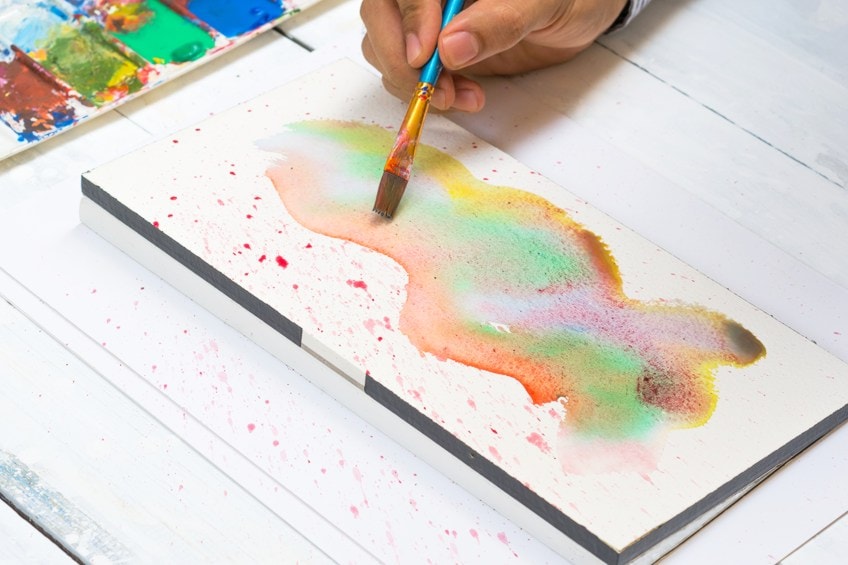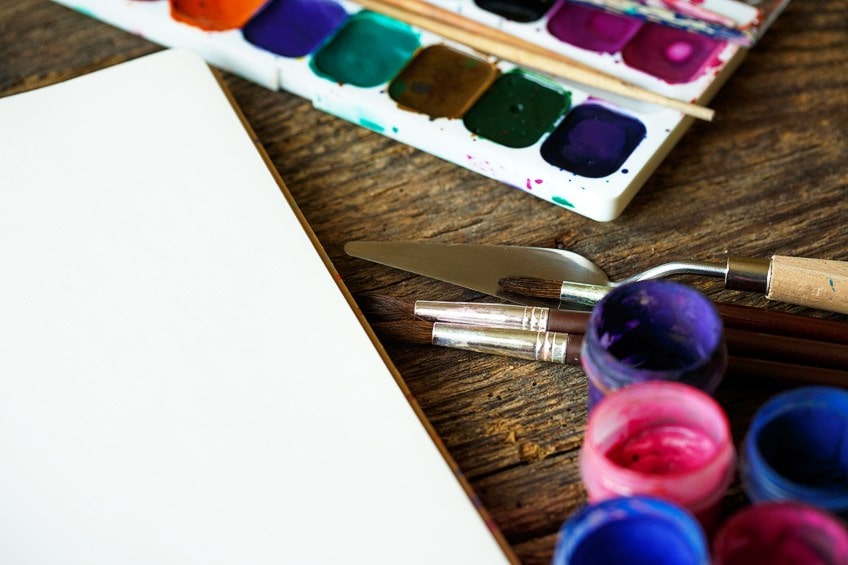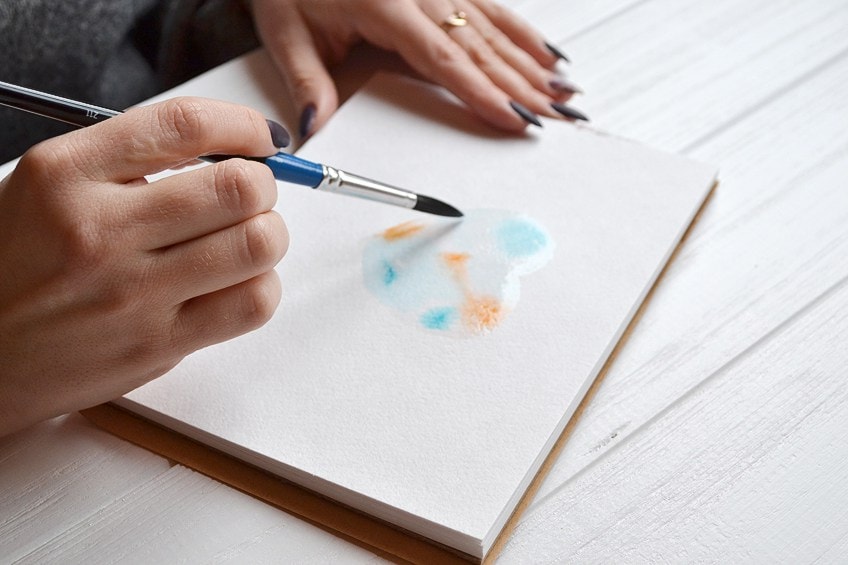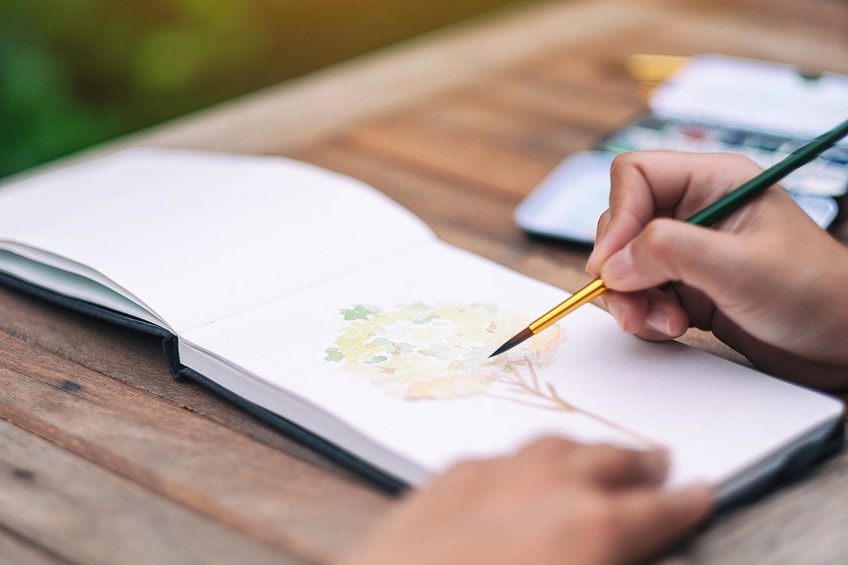what kind of paper to use for watercolor
If yous are only starting out on your watercolor painting journey, you volition have come up across a number of unusual names for items you will need, such as pan paints, spotter and rigger brushes, watercolor blocks and pads, and so forth. In this article, we are going to focus primarily on watercolor blocks, simply as well on other types of paper for watercolor painting.
Table of Contents
- ane What Is a Watercolor Block?
- 1.one Pros and Cons of Using a Watercolor Block
- i.2 How to Remove a Piece of Paper From a Watercolor Block
- two What to Look Out For When Buying a Watercolor Newspaper Cake
- 2.1 Quality of Watercolor Paper
- two.2 Textures of Watercolor Paper
- 2.3 Weights of Watercolor Newspaper
- ii.4 Other Formats of Watercolor Paper
- 3 Often Asked Questions
- 3.1 What Is a Watercolor Block?
- 3.2 What Is the Best Weight of Newspaper for Watercolor Painting?
- three.3 Can I Utilise Whatever Texture Watercolor Paper for My Painting?
What Is a Watercolor Block?
The paper you select for your painting is, without a doubt, the most important function of watercolor painting. Watercolor paper is specially designed to conform a great deal of water without getting saturated and soggy. Still, information technology has to be stretched properly in order to dry out flat before you can start painting on it. Stretching paper is quite a laborious process, but fortunately, watercolor blocks have done away with the need for it.
A watercolor block looks like an ordinary pad of paper, but instead of beingness glued merely at the top, the block is glued on all iv sides. The idea is that yous do your painting first, then remove the paper from the block when yous take finished.

Pros and Cons of Using a Watercolor Block
In that location are of course advantages and disadvantages of using a watercolor block rather than a regular pad or even loose sheets of paper. It really depends on your painting set-up and your own personal preferences. That said, if y'all are a beginner you will want to know all the pros and cons of a newspaper block before you can decide if it will work for you lot or not.
PROS
- The paper has been trimmed at the edges, which means you tin can paint to the border of the folio and not waste whatever infinite.
- The thickness and sturdiness of the cake provide a solid surface on which to paint, which means you tin easily paint outside without the aid of an easel.
- Considering the paper is attached on four sides, information technology will remain flat when you are painting on it. No risk of the page buckling under large washes of paint and water!
- Being a thick pad with a very rigid bankroll board, the newspaper is not likely to crease or crumple while you are carrying it.
- In that location is no need for you to stretch each canvas of watercolor paper before you can use it.
CONS
- Y'all can only work on one painting at a fourth dimension. If an artist has several commissions and is working to a deadline, so a newspaper block may non be the all-time pick for them.
- Some paper blocks tend to come up apart after the first few pages accept been removed, thus y'all are left with several loose sheets of newspaper. This may non be a problem if you lot piece of work in a studio, just since many artists are plein air painters (in other words, they work outdoors), a stack of individual papers may not be ideal.
- The pages of a watercolor block are not stretched as tightly as they would take been by hand. Even so, this might but be a instance of personal preference.
How to Remove a Piece of Paper From a Watercolor Block
Equally nosotros said earlier, the pages of a watercolor block are glued or jump in rubber on all sides, meaning that pages cannot exist torn off hands. Most bounden agents are clear or off-white, although some producers utilise black material. Y'all will demand to look carefully for a gap in the binding into which you lot can insert a thin, flat object such as a palette knife. These gaps are usually in the elevation left or right edges of the cake.
 Once you accept located the gap, utilise a palette knife or something like that does not take whatsoever sharp edges (a letter opener or a butter pocketknife would work just as well) to split up the pinnacle folio from the 1 below by running the knife slowly around the edges of the block and thus splitting the binding. Be conscientious to keep the pocketknife apartment and steady otherwise, yous might scratch or tear the page beneath information technology.
Once you accept located the gap, utilise a palette knife or something like that does not take whatsoever sharp edges (a letter opener or a butter pocketknife would work just as well) to split up the pinnacle folio from the 1 below by running the knife slowly around the edges of the block and thus splitting the binding. Be conscientious to keep the pocketknife apartment and steady otherwise, yous might scratch or tear the page beneath information technology.
You should but need to get around the paper block once earlier the page comes loose, only sometimes the binding is extremely tight so you might have to run your pocketknife around a 2d time.
What to Look Out For When Ownership a Watercolor Paper Cake
The globe of watercolor paper can exist a disruptive place considering not all paper for watercolor is created equal. There are several aspects to look out for in your watercolor paper, none of which should exist ignored if you are to get the best value for your money – and for your painting!
Quality of Watercolor Newspaper
Quality is, without doubt, the most important thing to consider before you purchase paper for watercolors, whether information technology is in a cake or pad, or loose sheets. There are only two grades of paper: student-form and professional-grade (as well known as artist-grade). The divergence is in how they are fabricated, and what they are made of.

Professional (Artist)-Class
Professional or creative person-grade watercolor paper is fabricated from 100% cotton, besides known equally rag newspaper or cotton paper. Cotton fiber is ideal for absorbing water and gives your paintings that unique await that only watercolors can achieve. The paper is made in a mold and has a textured surface. Professional-grade paper is archival quality and is besides acid-free and pH neutral.
Student-Grade
Pupil-grade paper is a mix of forest pulp and cellulose, and it does non absorb water the fashion that cotton fiber does, so your finished painting volition look different than it would on professional-grade paper. It has less texture to it because information technology is made by automobile, and dissimilar professional-grade paper, it is non-archival or pH neutral. That means the paper volition turn yellow in fourth dimension.
Textures of Watercolor Newspaper
You may have come up across the terms "hot-pressed", "cold-pressed", and "rough" in reference to paper for watercolor and not been sure what they mean. They refer to the different textures of newspaper and how information technology is made.

Hot-Pressed Paper
The term describes the procedure past which this type of newspaper is made. The paper pulp is pushed through heated cylinders to create newspaper with a polish, almost entirely texture-free surface. Of the iii dissimilar types of paper, hot pressed is the least absorptive, just you can exercise extremely fine detailed piece of work, for example, botanical paintings.
Common cold-Pressed Newspaper
The process for making cold-pressed newspaper is almost the same as for hot-pressed paper. Sheets of pulp are pressed through cold metallic rollers that are covered in felt, which contributes to the texture of the paper. In other words, cold-pressed paper has a texture whereas hot-pressed paper does not.
Cold-pressed paper has excellent absorbency, and although yous can do detailed paintings on it, they will not be equally finely detailed as they would on hot pressed paper.
Rough Paper
Crude paper is made in a mold, and so pressed through the same kind of felt-covered rollers that are used in making cold-pressed paper. The divergence between the ii types of paper is that rough paper is stale without existence press-stale, which means it dries with a rough, pebbly texture to information technology. You would not apply rough newspaper for detailed work, just for subjects that require a particularly textured look to them.

Weights of Watercolor Paper
You have no doubt seen reams of multipurpose press paper marked with its weight, usually 24 lbs or 80 gsm. Newspaper for watercolor comes in different weights too, the weight denoting the thickness of the paper. Simply as there are three types of textured watercolor, there are 3 different weight categories.
- Low-cal: Although this is more than than twice the weight of printing paper, information technology is the lightest of the watercolor papers available, and weighs 90 lbs or 190 gsm.
- Medium: Medium-weight paper is considerably heavier than low-cal paper, weighing 140 lbs or 300 gsm.
- Heavy: Heavy paper weighs over three times as much as a low-cal paper at 300 lbs or 640 gsm.
Mostly, professional watercolorists will utilize medium-weight paper because it does non require any preparation before painting, such every bit stretching. At that place is also no need to tape information technology onto a board to prevent information technology from crimper or buckling when water is applied. Even so, if you find yourself leaning towards working with very wet watercolors, in other words, with a lot of water, a heavy newspaper might be all-time for y'all.
Other Formats of Watercolor Paper
We have discussed watercolor blocks in detail in this article and alluded to other formats that watercolor paper comes in, namely, pads and sheets. Before nosotros discuss them, there is merely one more point to exist mentioned about watercolor blocks and that is that they will ever contain professional person or artist-course paper. Rarely, if ever, are they fabricated upwards of educatee-grade paper. We will now look at other formats of watercolor paper.

Pads of Watercolor Paper
Pads of paper for watercolors are about e'er fabricated from student-grade newspaper. The pads are either wire-bound, making it easy for you to turn over to a new folio and beginning painting, or they are taped along the left-manus side or the top of the pad so you can tear off one page at a time.
Sheets of Watercolor Newspaper
Loose sheets of watercolor paper are bigger than the pages in a pad or a block. You tin either buy them equally they come up or have them cut to size. More often than not it is professional person watercolorists who utilise loose sheets because they are of the highest quality. Even and so, as a beginner, yous may observe it more economical to purchase a few sheets and have them cut to the size you lot want, rather than investing in a big paper block or pad.
Too the quality of paper, another aspect of individual sheets of paper is that they are made with what is called a deckle edge. It looks like a natural tear in the paper, but only on the sides. The main body of the sheet of paper is not affected. A deckle edge just adds the finishing impact to a beautifully rendered watercolor painting.
Now that we accept introduced you to watercolor blocks and acquainted you lot with the various aspects that make up a good piece of watercolor newspaper, nosotros are sure that you lot will be eager to get started on your painting project! Remember, there are no rules that country which newspaper weight, texture, or format is better; it is entirely down to personal option. All you need to do is enjoy the selection process and get started with your painting!
Frequently Asked Questions
What Is a Watercolor Cake?
A watercolor block is a pack of professional-grade paper for watercolor that is bound or glued on all four sides. There is a pocket-sized gap in the bounden into which yous can insert a palette knife or something similar (every bit long equally it does non have whatsoever sharp edges), and run it effectually the whole block then you tin can tear off the page when yous take finished your painting.
What Is the Best Weight of Paper for Watercolor Painting?
I weight is non necessarily better than another; it depends on the blazon of watercolor painting you are doing, and, of class, personal option. However, it is more often than not recommended that medium-weight newspaper that weighs 140 lbs (or 300 gsm) exist used.
Can I Utilize Any Texture Watercolor Paper for My Painting?
Information technology depends entirely on what kind of painting you are doing. If information technology is a very finely detailed painting, hot-pressed paper, which is a smooth paper with no texture, would be platonic. Cold-pressed paper, that is, paper with a slightly textured surface is the nearly pop amongst watercolorists. Nonetheless, artists who like to work with very wet paints would probably go for rough paper which, as its name suggests, has a rough and heavily textured surface.
Source: https://artincontext.org/what-is-a-watercolor-block/
0 Response to "what kind of paper to use for watercolor"
Post a Comment